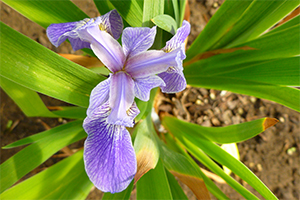Plants of the Garden
Climate change information is growing each year, and with what we know about predicted changes in temperature and preciptation in this region, care was taken to select plants that would demonstrate variation in their development when exposed to these conditions.
The garden's plants can be divided into two categories—native perennial plants, which are plants that rely on pollinators for reproduction and annual food crops, which are plants that contribute to our diet. Below you will find the list of the specific plants chosen for this year:
Native Perennial Plants
- Monarda fistulosa (Wild Bergamot)
- Monarda didyma (Scarlet Bee Balm)


- Penstemon digitalis (Foxglove Beardtonque)
- Penstemon hisutus (Hairy Beardtongue)


- Hypericum kalmianum (Kalm St. John's Wort)
- Hypericum prolificum (Shrubby St. John's Wort)


Annual Food Crops
- Wheat 'Tom'
- Wheat 'Glenn'
- Wheat 'Red Fife'


- Bean 'Jubba'
- Bean 'Masai'


- Broccoli 'Marathon'
- Broccoli 'Bay Meadows'
- Broccoli 'Packman'


Why is it important to study these plants?

Phenology and climate change
Phenology is an important part of understanding plants and their roles in ecosystems. It requires observing many biological events, like when the seasons change, when the insects hatch, when the flowers bloom, and how they respond to change. With climate change, the study of phenology is becoming more important. As temperatures continue to rise, there is a concern that flowers may bloom earlier, and that pollinators of those plants may not be present at that time to pollinate them. This is known as phenological mismatch. Without those pollinators, the plants may be less likely to successfully pollinate and produce fruit and seeds. Research suggests that early blooming plants may be at greater risk of phenological mismatch, because when they bloom early in the growing season there may be fewer pollinators present to pollinate them.
Other possible climate impacts to plants could include changes in plant stress, fruit or seed productivity, plant growth, or susceptibility to disease and pests. The Climate Change Garden demonstrates how projected growing conditions may affect plant growth so visitors can gain a better understanding of the effects climate change may have on their life cycle.
Food Crops
The wheat, beans, and broccoli grown in the garden are all widely-grown food crops that have the potential to show changes in their rate of growth, productivity and/or lifespan due to climatic changes. It is important to understand how these important crops will be affected, especially wheat, which is a grain that helps to provide the majority of calories in diets worldwide.
More research is needed to fully understand the effect climate change has on these plants that we rely on for survival and well-being.









